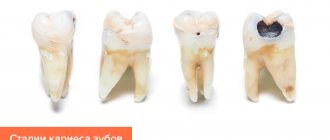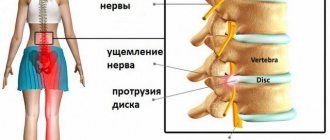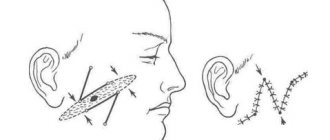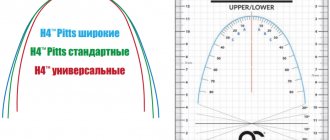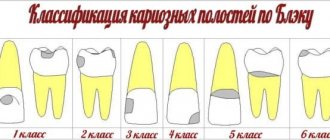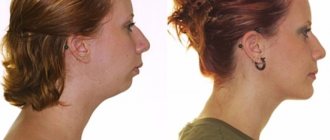Each tooth in a row has its own unique shape; it is standard for every person. Of course, this does not mean that all people on the planet have the same teeth. On the contrary, dental impressions, like fingerprints, are unique in their anatomical features.
The presence of deviations in the formation of dental crowns from the standard, physiological form is called an anomaly in the development of tooth shape. As a rule, abnormal tooth shapes are combined with changes in the size of the dental units.
Reasons contributing to the development of abnormal tooth shapes
Based on numerous studies, scientists have come to the conclusion that the formation of dental anomalies occurs during pregnancy.
There are two main reasons that contribute to the abnormal development of tooth shape:
- Endogenous (independent of external factors, inherent within the body) - Down syndrome, Shershevsky-Turner syndrome, Waardenburg syndrome, Seckel syndrome, Lobstein-Vrolik disease (osteogenesis imperfecta), endocrine disorders.
- Exogenous (the result of external influences) - fetal hypoxia, deep toxicosis, infectious diseases of the mother, use of drugs, alcohol, narcotics during pregnancy, complicated childbirth.
Due to the above reasons, hypoplasia (underdevelopment) of tooth enamel may develop, which also leads to deformation of dental units.
Stages of treatment
Correction of this anomaly includes two main stages: preparation and treatment. Due to the nature of the development of the disease, both stages are mandatory.
Only some manipulations carried out within each stage can be varied or excluded .
Preparatory activities
The preparation stage is primary and important, as it ensures the effectiveness of subsequent treatment.
The following preparatory measures are used:
- sanitation of the oral cavity . It provides not only professional cleaning, but also treatment for caries, replacement of unstable fillings and restoration of damaged teeth;
- splinting with subsequent restoration of full stability. This procedure must be carried out for loose teeth. Further correction of the anomaly is impossible without this stage.
For a detailed article on dental edentia, read the link.
In this publication we will look at what trema looks like before and after treatment, and the effectiveness of the methods used.
Here https://orto-info.ru/zubocheliustnye-anomalii/zubov/kolichestva/gipodentiya.html we will talk about in what cases hypodontia of primary teeth is observed.
Treatment tactics
Treatment will depend on the signs of pathology and their severity:
- When teeth are crowded and rotated, with the absence of teeth and diastemas, braces are used .
For this, both metal and ceramic braces can be used. They will not correct the size of your teeth, but they will give them the correct shape. If there are wide gaps, this method is considered ineffective. It does not provide permanent stability and causes the teeth to deviate towards the tongue. It should be borne in mind that the larger the gap, the more the teeth will sink. - Veneers will help correct trema and diastema .
They are ceramic or composite plastics of minimal thickness that are fixed to the vestibular surface of the tooth. Overlays allow you not only to visually eliminate gaps, but also to change the width of the visible part. - For excessively small teeth, prosthetics .
For this purpose, artificial crowns are used, which are installed directly on the teeth. If the condition and height of the tooth do not allow the installation of artificial crowns, preliminary removal and prosthetics are carried out using a bridge-type structure.
Photos before and after microdentia treatment
Types of tooth shape anomalies
The abnormal shape of the dental crown is mainly distinguished by the front, lateral incisors, both upper and lower, supernumerary teeth, and less commonly, molars.
Depending on the appearance of the manifestation of the pathology, anomalies in the shape of the teeth have the following varieties:
- Giant teeth - an increase in the central incisors by one and a half times. The result is a violation of physiological occlusion.
- Spike-shaped teeth - the central and lateral incisors of the upper jaw and the lateral incisors of the lower jaw acquire this shape.
- Ugly teeth - come in many forms; the crowns of the anterior teeth are affected.
- Fournier's teeth - the incisors of the central part of the upper jaw have a barrel-shaped, screwdriver-shaped appearance. The cutting edge of the dental crown is smaller than its neck.
- Hutchinson's teeth differ from Fournier's teeth by the presence of a semicircular hole on the cutting surface of the tooth. The enamel in this place is thinned, or even completely absent.
- Pflueger's teeth - the first molars are modified. They differ in the smaller size of the chewing surface from their coronal part.
Consequences
The incorrect size of even single specimens can lead to deformation of the entire row of teeth, which in turn provokes the development of possible consequences.
Most often, pathologists note the following consequences :
- displacement of the anterior incisors in the distal direction. This result can only be observed if the lateral incisors are also small in size;
- violation of stability .
The small dimensions mean that there is no full contact between the side surfaces, which provided additional stability. Without constant support, the ligaments in the dental bed are stretched, causing the tooth to become mobile; - violation of speech functionality . With microdentia, a change in diction is often observed, whistling and hissing sounds are most pronounced;
- improper functioning of the temporomandibular joint . It is observed in a generalized form of the disease, due to improper distribution of the load during chewing and increased muscle tone in a separate area of the jaw;
- psychological discomfort , which is provoked by the presence of trema and diastemas;
- inflammation of periodontal tissue caused by bacteria accumulating in wide spaces between teeth and enlarging gum pockets when loosened.
What is such an anomaly in the number of teeth as hyperdontia, we will tell in a new review.
In the next article we will talk about cases in which macrodentia in a child is considered a deviation.
At this address https://orto-info.ru/zubocheliustnye-anomalii/zubov/polozheniya/krivyie.html you will find photos and recommendations on how to prevent the appearance of crooked teeth in children.
How modern methods are used for dental restoration in case of dimensional pathologies, watch the video:
Diagnosis of tooth shape abnormalities
Consultation with an endocrinologist and geneticist will help determine the cause of this pathology. Choosing the right method for eliminating pathology is the job of a dentist, orthodontist, or surgeon.
For diagnosis, it is necessary to undergo a series of studies, which include:
- careful collection of anamnesis;
- studying diagnostic casts of the patient’s dentition;
- cone tomography;
- various types of radiographic examinations;
- electromyography (study of the functionality of facial muscles).
Causes and symptoms of dental abnormalities
Causes of dental abnormalities include:
- Congenital syphilis;
- Heredity;
- Thyroid diseases;
- Injury to the fetus during childbirth;
- Rickets;
- Hypovitaminosis;
- Complication of caries;
- Lack of space in the dentition;
- Neoplasms of the jaw;
- Chronic inflammatory processes in the area of the roots of temporary teeth;
- Early tooth loss;
- Underdevelopment of the alveolar process of the jaw
Symptoms of dental anomalies may be absent for a long time, and pathology can be detected by chance during an examination by a dentist. With pronounced anomalies, malocclusion occurs, visible defects of the jaw and dentition, as well as problems with chewing.
Methods for treating abnormal tooth shapes
It is important to remember that treatment of any pathology associated with correcting the shape of dental crowns begins after the formation of a permanent bite. Anomalies in the shape of teeth are primarily a big aesthetic problem.
Methods of modern prosthetics make it possible to correct almost the most complex cases of dental anomalies:
- Restoration using ceramic veneers - such microprosthetics are performed by attaching a thin ceramic plate to the previously prepared front surface of the tooth. This procedure allows you to cope with the rather complex task of smile aesthetics in a short period of time.
- Prosthetics with crowns is considered appropriate when additional strengthening of the tooth is required. The material for making crowns can be different: a metal alloy of medical or noble metals, metal-ceramics, metal-plastic, ceramics. The choice depends on the aesthetic preferences and financial capabilities of the patient.
- Restoration with composite materials is possible for minor dental anomalies. It is one of the most affordable and fastest methods of dental crown reconstruction.
- Tooth resection - supernumerary and giant dental units are removed. This is followed by bridge prosthetics or installation of dental implants.
Diagnostics
Despite the specificity of the signs of the anomaly, it is not always possible to identify its form with the help of a visual examination .
To make an accurate diagnosis, an instrumental examination is used using a measuring instrument to determine the total width of the incisors of both jaws.
If the resulting sum for the upper jaw was 28 mm, and for the lower jaw 22, then this is the primary sign of microdentia. But even this method does not always allow one to accurately determine the form of pathology.
In order to carry out an accurate diagnosis, additional techniques must be used to identify the cause of the disease, determine the degree of anomaly and the quality of adjacent tissues.
How to distinguish it from other diseases?
One of the important stages of the examination is differentiated diagnosis, which will distinguish microdontia from other diseases. Most often, this pathology is confused with impacted teeth.
To exclude the coincidence of anomalies, it should be taken into account that impacted teeth are characterized by late eruption , which is unusual in microdentia.
Also, impacted teeth most often take an incorrect position during their development, in contrast to microdentia, when they most often have the correct position, but are only slightly reduced in size.
During microdentia, the developing tooth is close to the gum tissue, and the impacted tooth is most often located deep under the gum.
Diagnostic methods
Mandatory and additional diagnostic methods used for this type of anomaly include :
- intraoral radiography . It is used to reduce the size of individual teeth and allows you to determine the condition of the root part;
- orthopantomography . Designed to identify the quality of dental and bone tissue;
- occlusal diagnostics , which is carried out using special rollers. It makes it possible to determine the presence of deviations in the development of occlusion;
- taking impressions , which allow you to study in detail the features of the anomaly.
Prevention of dental abnormalities
The only method of preventing this disease is to provide the expectant mother with appropriate conditions:
- nutritious, varied nutrition;
- regular, high-quality medical care;
- protection from stressful situations.
It is necessary to forget about existing bad habits during pregnancy and breastfeeding. Particular attention should be paid to the development of the child in the first year of life. Natural feeding and prevention of rickets are a solid foundation for the excellent health of the baby.
Causes
Small jaw. First of all, bad childhood habits and developmental features affect them: infantile type of swallowing, mouth breathing, prolonged sucking of a pacifier or bottle, poor nutrition, predominance of soft foods, lack of chewing load. Also, underdevelopment of the jaw bone can be caused by the early loss of baby teeth and the long absence of permanent teeth in their place, heredity, and intrauterine disorders.
Narrowing of the dental arches. It occurs due to soft tissue dysfunction, which, in turn, can be caused by hormonal disorders, injuries, metabolic disorders, heredity, or malocclusion.
Too rapid change of teeth (up to 6-7 years). The jaw bones cannot keep up with the growth of permanent teeth, so they do not have enough space. It is not known for certain why in some children the replacement of baby teeth with molars occurs earlier than expected. This feature is due to individual anomalies in the formation and eruption of teeth.
Pathological growth of teeth. “Eights”, or third molars, erupt quite late, at 16-27 years old, and they often no longer have enough space. As they grow, they move adjacent molars and push the entire row, which can cause crowding of teeth. Other provoking factors are hyperdentia, or supernumerary, extra teeth, and macrodentia - an increase in the size of one or more teeth.
Anomalies of teeth position
Violation of the arrangement of teeth in a row also has its own classification:
- deviation of the crowns of the teeth relative to the dentition: the distal position indicates the deviation of the tooth back along the dentition relative to its normal position, the mesial position means forward;
- displacement of the growth points of the teeth relative to the dentition: the vestibular position means the displacement of the tooth closer to the vestibule of the oral cavity (lips), the oral position means the displacement closer to the oral cavity;
- rotation of the tooth around its axis.
All tooth position anomalies are corrected using braces or modern silicone aligners.
How to calculate proportions
The severity of pathology can be determined using special calculation formulas:
- Gerlach's method involves dividing the row into three separate segments - the front and two side ones. When calculating, the length of each section is measured, the value of the lower one is obtained by multiplying the size of the upper one by 1.35. The data is compared with the tabular ones, which makes it possible to determine normality or pathology.
- The Pon-Linder-Hart method can be used for temporary and permanent dentition. The calculation procedure includes calculating the total width of the incisors and calculating data using a special formula. The obtained value is compared with the numbers given in the table, after which the doctor makes a conclusion and draws up a correction scheme.
- Calculation of the degree of pathology using the Corkhouse method. The method consists of measuring the width of the incisors for the front section and comparing the actual data with the standard ones.
Why do teeth grow incorrectly?
Causes of abnormal position of teeth:
- jaw growth disorders;
- improper formation of tooth germs;
- failure of teeth growth and bite changes;
- discrepancy between the sizes of primary and permanent teeth, general macrodentia;
- presence of supernumerary teeth;
- early loss of baby teeth;
- partial edentia;
- jaw injuries.
The condition can be aggravated by the lack of timely dental care and various general factors, such as the composition of the diet, region of residence, the level of physical activity of the child, the presence of systemic diseases, etc.
Anomalies in the number of teeth
One of the most common pathologies is a deviation from the standard number of teeth in one row. The main symptom of deviation is single or multiple absence of teeth due to their failure to erupt. Also, a smaller number may be due to the combination of several teeth into one during the period of their development and eruption. Most often, such an anomaly occurs on the front teeth and incisors located in the lateral part. This localization of the process causes microdentia - a disease characterized by tooth reduction or absence in the pathological zone on one or the other side of the upper jaw. In dentistry, the anomaly of missing teeth is called adentia. It can be partial or complete. Additionally, a tooth may develop in the jaw but not erupt, which is called impaction. When teeth are retained, their formation is almost complete, but the roots of the tooth are absent. The absence of teeth is due to a violation of the formation process, when the tooth germ has not formed. Most often, the cause of an abnormal number of teeth is a person’s genetic predisposition. The above anomalies are treated with prosthetics, sometimes in combination with orthodontic treatment.
Along with an incomplete set of teeth, supernumerary teeth also occur - when the number of teeth in a row significantly exceeds their normal number. The localization of such an anomaly most often occurs in the area of the front teeth. The shape of teeth located in an unnatural place is spike-shaped, but in some cases they can be similar to nearby teeth. The main reason for the increased number of teeth is dysfunction of the development of the dental epithelial plate. The treatment technique for such dental anomalies is selected individually for each case and depends on factors such as the location of the superset of teeth, the influence of the teeth on the permanent teeth. If the permanent teeth on the jaw are displaced, then treatment consists of removing the abnormal teeth and subsequent orthodontics. In cases where the grown abnormal tooth does not disturb the position of permanent teeth, its removal is not performed - the shape of the tooth crown is changed using prosthetics.
Features of some anomalies
Small teeth deviate from the normal size by 1.5 mm or more. The distance between them can be seen with the naked eye. The defect most often affects the incisors; the cutting part has a wavy or jagged shape.
There are three forms of microdentia - isolated, relative and generalized. The first is characterized by damage to individual front teeth. With the second, there is an increase in the jaw. Against this background, normal-sized crowns will look small. In the generalized form, all teeth are small.
Such a defect leads to impaired diction, the occurrence of periodontal disease, row displacement and the appearance of gaps. Due to poor contact between the lateral surfaces, teeth become unstable and may fall out early.
There are 5 types of marocdentia. With a localized form, the growth of single crowns is disrupted. They stand out noticeably from the crowd. In isolated cases, only one front incisor is enlarged. Deviations from the norm can be 5−6 mm. Generalized is characterized by damage to the entire dentition of the jaw. For the absolute shape, the size of the incisors is determined. For the upper ones - length from 35 mm, for the lower ones from 28 mm. When relative, the length of the upper ones does not exceed 35 mm, the lower ones 27 mm.
The consequences of macrodentia include malocclusion, an increased risk of stomatitis and gum disease. An ugly smile contributes to the development of psychological problems.
Expert opinion
Ravcheeva Yulia Anatolyevna
General dentist
Many people believe that with this pathology one should consult a specialist only in case of a large deviation from the norm. But without timely treatment, numerous complications may occur: trauma to the mucous membrane, malocclusion, disruption of the eruption of adjacent teeth, and psychological problems.
Prevention of the development of micrognathia and macrognathia
Let's talk about possible measures to prevent the development of maxillofacial anomalies. Since the influence of negative factors on the health of the child’s future dental system is especially active during the mother’s pregnancy and in the first months of the baby’s life, preventive measures must be followed even before the birth of the child and in the first year of life . To promptly prevent the development of dentofacial deformities, you should adhere to the following:
- carefully monitor the course of pregnancy, try, if possible, to avoid the risk of infectious diseases of the expectant mother;
- try to avoid long stays of a pregnant woman, mother and baby in an unfavorable ecological environment;
- eat a nutritious and varied diet and lead a healthy lifestyle during pregnancy;
- give up bad habits in the process of planning pregnancy, during pregnancy and breastfeeding;
- adhere to proper feeding of the baby (use an anatomically correct nipple and discard it in a timely manner; when artificially feeding, make sure that the bottle with the mixture does not put pressure on the alveolar processes);
- if possible, stop bad habits (sucking and biting fingers and cheeks, tongue, various objects) that provoke deformations of the dentition, disturbances in the growth of the jaw bones;
- observe the timing and sequence of teething, monitor the development of speech;
- promptly identify and eliminate congenital pathologies in the form of a shortened frenulum, cleft lip, palate, etc.;
- wean the child from sucking fingers, objects, etc.;
- conduct myogymnastics with the child to prevent disorders of respiratory, swallowing, and speech functions; ensure that the child does not breathe through his mouth;
- timely treatment of baby teeth and periodontal diseases;
- adhere to preventive measures and promptly treat common diseases (rickets, diseases of the ENT organs, endocrine pathologies, etc.)
Thus, in the prevention and timely identification of risk factors that contribute to the occurrence of various dental anomalies, the most important thing is the active and careful participation of parents at all stages of the child’s growth and development.
Surgery. Forecast
The doctor assesses the need for correction of macrognathia and micrognathia based on detailed diagnostic data, medical indications, and the wishes of the patient himself, taking into account his state of health and emotional state.
The solution to most problems associated with unexpressed disorders can consist of conservative treatment , the use of various orthodontic systems. In case of pronounced skeletal disorders, in cases where there are also concomitant significant functional and aesthetic disorders, it is advisable to resort to combined orthodontic-surgical treatment , which will be aimed comprehensively at simultaneously eliminating both aesthetic and functional disorders. During complex treatment, including orthodontic preparation and subsequent orthognathic surgery, extensive joint work is carried out between the orthodontist and the surgeon, aimed at correcting the bite, changing the shape and position of the bone structures of the face.
Orthognathic surgery requires high-quality orthodontic preparation (on which the correct closure of the dentition after surgery and the final predicted result of the entire combined treatment depend) and detailed planning. Orthognathic surgery is performed under anesthesia through intraoral access. The surgeon moves the jaws, changes their shape if necessary, gives the jaws the correct position and secures them with special fixing elements. Upon completion of the rehabilitation period and the end of the orthodontic treatment stage, the final result no longer requires any additional correction and remains stable throughout life.
Thus, once having corrected the functional and aesthetic disorders of the maxillofacial area and restored the harmony of facial features at the level of not only the dentition, but also the jaw bones, a person forever forgets about the problems that previously bothered him.
Complications
Microdentia not only causes psychological discomfort, but also negatively affects functionality. In some cases, the problem causes organic disorders, somatic diseases, for example, problems with the gastrointestinal tract due to insufficient chewing of food. The most common complications for the dental apparatus are:
- distal displacement of the coronal part;
- the formation of gaps with loss of stability, excessive load when chewing food;
- problems with diction;
- development of periodontal disease, periodontitis.
When diagnosing a problem such as short teeth, it is imperative to begin treatment. Timely correction eliminates many complications and excludes the development of other pathologies.
Anomalies in the structure of hard dental tissues
This pathology is characterized by deposits on the surface of the tooth. With hypoplasia and hyperplasia, an accumulation of chalky spots appears on the teeth, and all teeth in a row are immediately affected, occlusion is disrupted, and unnatural bumps appear on the chewing surfaces.
When a patient has an anomaly such as amelogenesis imperfecta, the surface of his teeth becomes covered with pigment spots that have a characteristic brown or yellow color.
With dentinogenesis imperfecta, dysfunction of dentin formation is observed. In this case, the teeth acquire a yellow-brown color and are characterized by rapid wear.


